This article was published in Scientific American’s former blog network and reflects the views of the author, not necessarily those of Scientific American
Carrying on from my previous blog highlighting the female orangutans at my research site Sikundur, this week it’s the turn of the males who call the site “home.” I’ve been fortunate enough to encounter a large number of these guys over the past year, perhaps due to the site’s position of the edge of the national park compressing these animals’ home range as they suffer the effects of rampant deforestation across the Leuser Ecosystem. In fact, while historically studied Sumatran sites have a ratio of around 1 flanged male for every 2 unflanged males, Sikundur has the reverse ratio of 2:1, found in Bornean sites. Interestingly the food distribution (both in space and time) is very similar to Bornean sites, so, perhaps this explains this expression of male bimaturism at Sikundur, as well as a number of “Bornean” characteristics to the males’ behavior:
ADOLESCENT
.JPG?w=500)
Credit: James Askew
On supporting science journalism
If you're enjoying this article, consider supporting our award-winning journalism by subscribing. By purchasing a subscription you are helping to ensure the future of impactful stories about the discoveries and ideas shaping our world today.
Kundur (8-10 years old)
First Encountered: 1/9/2013
Kundur, the first orangutan ever found at Sikundur, is the youngest male at our site, and can only recently have left his mother, since he’s absolutely tiny! He doesn’t like observers frequently kiss-squeaking and throwing branches, which combined with his speed and agility makes him a difficult proposition to follow. However, this adolescent orangutan loves to play with all orangutans he comes into contact with both females and their infants alike, though on one memorable occasion, he got too close to one of the big flanged males, Ompung, who promptly chased the screaming youngster down through the trees.
UNFLANGED BUT ADULT:
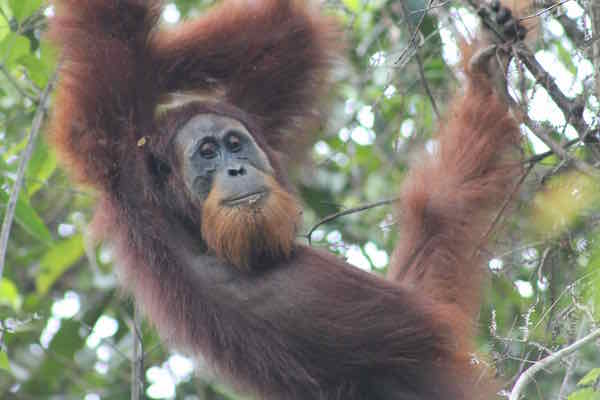
Credit: James Askew
Bendot Kecil / Brutus (15-20 years old):
First Encountered: 1/5/2014
Bendot Kecil (“Little Goat”) aka Brutus is one of two unflanged males at our site, and the scourge of many of the females, which he’ll often follow around and harass for copulations. Although we’ve only seen him encounter females with unweaned infants (who don’t resist his amorous intentions since there’s no risk of pregnancy), until we’ve conducted genetic studies we cannot say for sure if he’s fathered any of our infants. He does not really like observers very much, frequently kiss squeaking, and has been observed producing long calls, albeit very different sounding to that of the big males, which, based on previous studies, seems to be extremely rare for unflanged males.
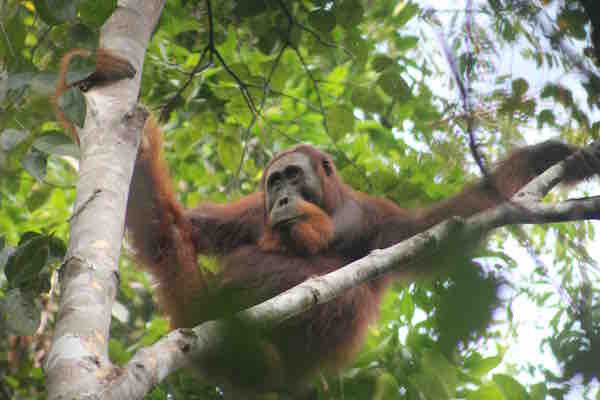
Credit: James Askew
Anto (15-20 years old):
First Encountered: 11/6/2014
Making a mockery of that previous statement, Anto is our other unflanged male and has also been observed producing long calls! We’ve only encountered him on very few occasions, though the similarities in size and appearance with Bendot Kecil make identifying him a tricky proposition, so we may in fact have followed him more often than we think! Interestingly, he’s show up a few times when we’re following long calling flanged males, perhaps indicating he’s trying to “sneak” copulations with any receptive females who’re attracted to the flanged male, using his smaller stature to travel quickly through the canopy while his larger counterpart blunders around.
TRANSITIONAL
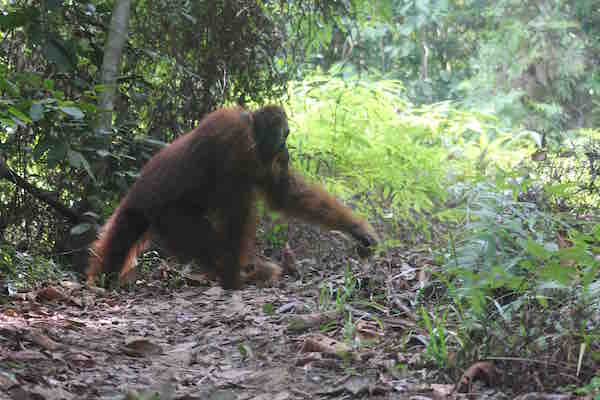
Credit: James Askew
Bendot Besar (20-25 years old)
First Encountered: 8/9/2012
The only transitional male at the site, Bendot Besar (“Big Goat”) is currently developing the fatty cheek pads known as flanges, though he’s almost there. He has recently begun to produce his long call, and it sounds quite high pitched and “reedy.” Although his cheek pads haven’t come in fully, he’s still a big animal, and spends a large amount of time on the ground. In fact, while all previous studies of Sumatran orangutans have concluded them to be almost totally arboreal, we’ve found our flanged males and even some of the females to use the ground regularly for a number of reasons, including travel, avoiding harassment, and foraging, much like their Bornean counterparts. Perhaps, this is because of the patchily distributed and seasonal food availability of the site, though, given Sikundur’s history as a logging concession, habitat disturbance may also be increasing the amount of time animals spend behaving terrestrially. Bendot is a delight to follow, however, we only encounter him very infrequently, so we think he ranges large distances outside of our area, which is typical for males who have homes ranges greater than 3,000 ha.
FLANGED
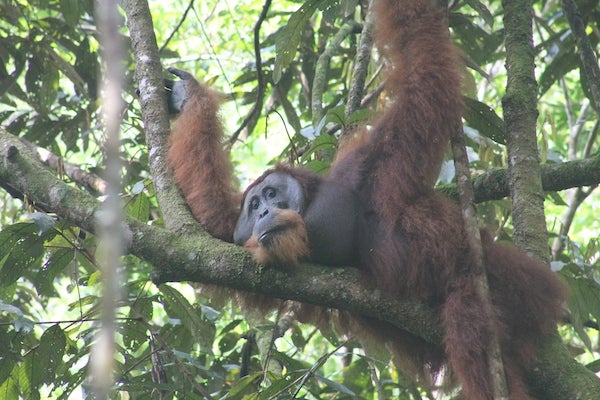
Credit: James Askew
James (30-35 years old):
First Encountered: 21/6/2014
Despite not being the largest, we think James is probably the dominant flanged male present at our site based on other males’ responses to his long calls. He calls at a fearsome rate of more than 20 per day, with some calls lasting over 10 minutes! Easily distinguished by the broken middle finger on his left hand, and, index and pinky fingers on his right, following this flanged male can be a little tricky since he’s not well habituated and can be a bit aggressive towards researchers and field staff alike (though not as bad as Bornean orangutans)! He seems to like the area to the North of the research area, and we’re interested to find out if he makes it all the way to Orangutan Information Centre (OIC)’sreforestation site a few kilometers in that direction.
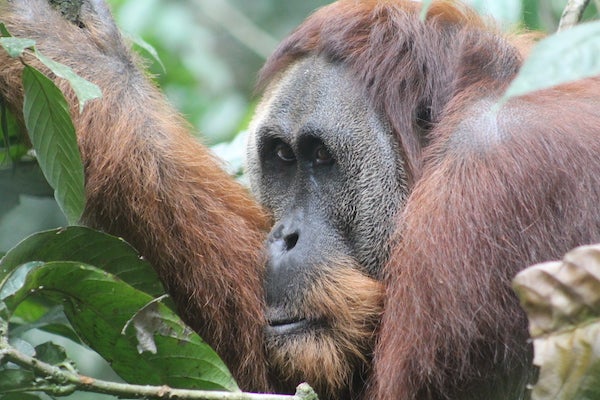
Credit: Sonny Royal / SOCP
Ompung (25-30 years old)
First Encountered: 5/9/2012
Ompung, meaning Grandfather in the local Batak language, is the flanged male we’ve followed the most at Sikundur, making him an absolute delight to study! He lets us come really close, considering how low in the canopy he travels, yet still gives us very natural behavior, including a fairly high number of long calls, some interesting feeding choices, and a lot of sleeping! While we don’t think he’s the dominant yet – he runs from James’ long calls and the females pay no attention to him whatsoever – he is in absolutely amazing condition, and could well take over in the future!
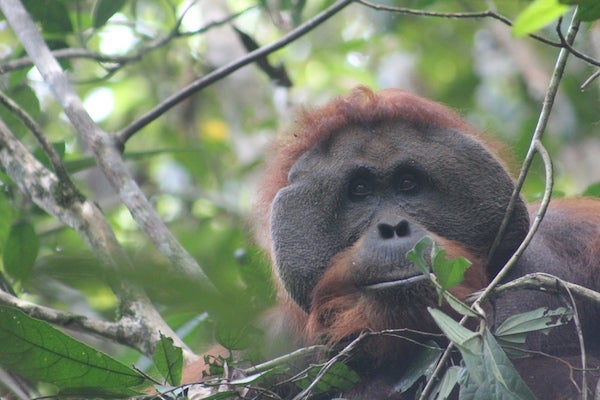
Credit: James Askew
Mat Pengkor (25-30 years old)
First Encountered: 11/9/2012
Mat Pengkor is named for our director of research, Matthew Nowak, and for one of the field assistants who has an extremely slight limp, earning himself the rather unfortunate (and extremely unfair) nickname “clubfoot” amongst the other field staff (as an aside, Indonesians are much more blunt than Westerners; e.g. if you put on weight the first thing anyone says is “you’ve gotten fat”. It takes some getting used to!). After a two-year absence, Mat finally reentered the site in recent months, producing large long calls as befits the biggest male at our site. Easily distinguished by a small notch in his flanges presumably from fighting, (scars like this are great for us, as they make it very quick and easy to identify males, who do tend to change a lot!), Mat is definitely a favorite of our research team given his good looks and relaxed demeanor.
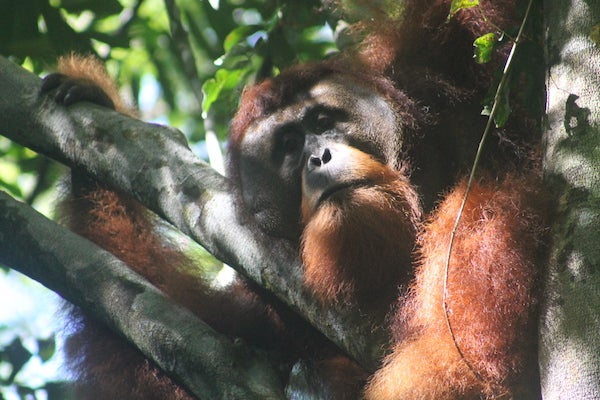
Credit: James Askew
John (25-30 years old)
First encountered: 13/7/2015
John is the newest orangutan found at the site, and seems to be a bit of a fighter judging by the large scar on his right cheek. As noted in my previous blog, the first time we followed him, he came across one of the female orangutans Raquel, and repeatedly attempted to force copulations. This was the first time I’d seen aggressive coercion like this amongst our population, though it has been shown to occur infrequently at other sites. In Borneo, however, the much larger flanged males are extremely aggressive and will often coerce females in this way, as well as being quite aggressive towards researchers, coming down to the ground and charging. Fortunately, Raquel got away (as you’ll read below), and John, though a little frustrated with our presence, didn’t charge us as we observed.
Hombing (20-25 years old)
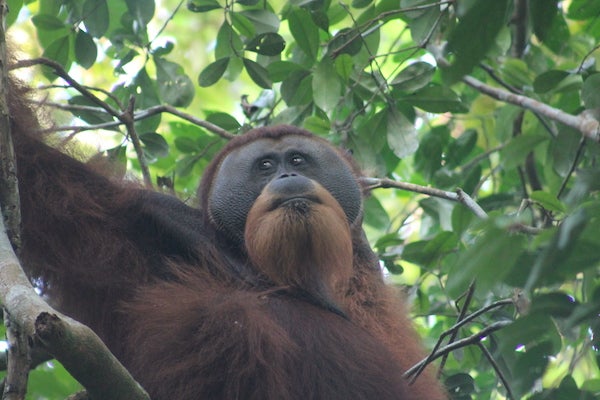
Credit: James Askew
First encountered: 8/7/2015
Hombing, taken from a common Batak family name, was found in the same week as John, in the same part of the grid. Indeed the two had a brief encounter, coming within a few hundred meters of one another when John was attempting to mate with Raquel. Hombing, we think, heard Raquel’s screams, and long called in response from close by. John immediately moved in that direction and began long calling at a high rate – four in the next hour. It appears Hombing is subordinate, since he stopped calling and moved away, and John continued to search aggressively for the remainder of the day. However, the prospective conflict did provide enough of a distraction that Raquel was able to escape.
Hombing is an interesting-looking animal with his very diamond shaped face, however he actually proved to be a bit of a nightmare to follow, waking up before dawn, and going to sleep after dark, but actually not doing very much in the time between!
I hope you’ve enjoyed hearing about the animals at Sikundur! To learn more about the Monitoring Station and the Sumatran Orangutan Conservation Programme visit the website here.